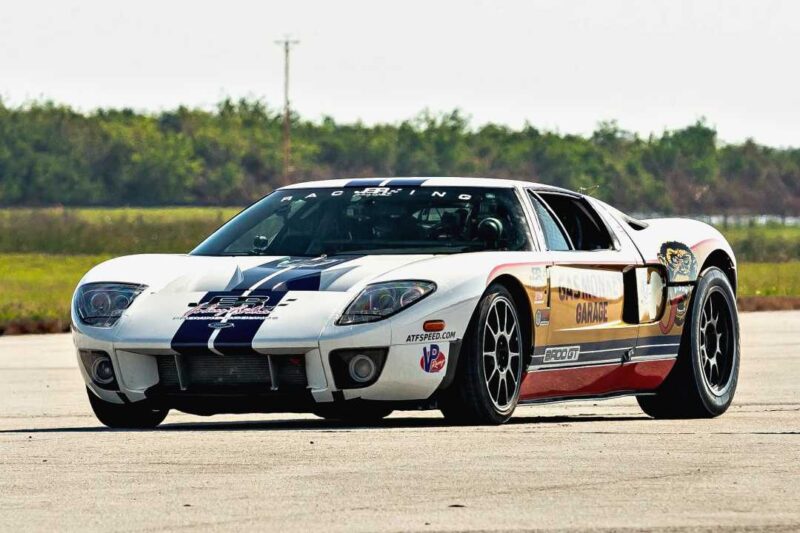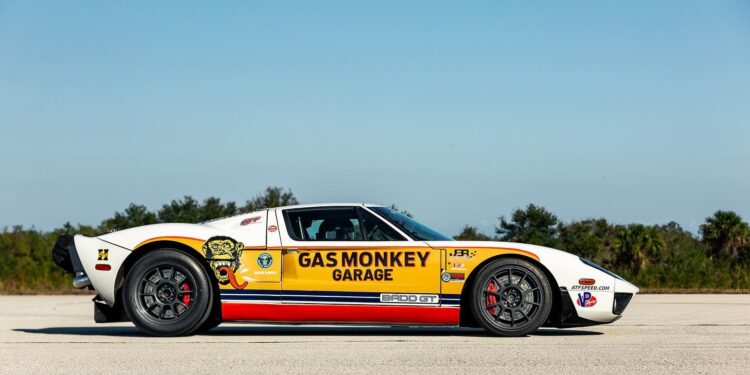In the high-stakes world of top speed record runs, which often involve wind tunnels, simulators, and multi-million dollar R&D budgets, Johnny Bohmer is doing things the old-fashioned way with good old seat time, street tires, and a lot of guts.
Back in December 2022, Bohmer and his heavily modified 2006 Ford GT, known as the BADD GT, hit a verified 310.8 MPH (500.1 KPH). Now, he’s preparing for something even more audacious: a 330 MPH (531 KPH) run in what is a fully street-legal car. This would place him nearly 25 MPH ahead of Bugatti’s 304.77 MPH record in 2019, and well past any officially verified attempt by Koenigsegg or SSC.
The BADD GT still runs using a 5.4-liter aluminum Ford V8. It’s the original block, with a Ricardo transmission housing, now packed with a straight-cut dog box and supported by 2,700 wheel horsepower at the wheels. Bohmer says the car wasn’t even running full boost for the 310 mph run.
Only about 2,100 horsepower was used. All this performance while it still packs working air conditioning, cup holders, insurance, and Florida plates. Since no tire on the market is officially rated for speeds above 187 MPH, Bohmer used off-the-shelf Michelins DOT-approved street tires from Tire Rack. This is a car that Jonny has owned since new and is still his daily.

Now, Top-speed runs like these are exceedingly rare, partly because there are only a handful of places in the world where such attempts are even possible. Where land-speed record runs can happen at places like the salt flats of Utah, for production cars, a paved surface is ideal. Bugatti Chiron Super Sport 300+’s 304.77 MPH run took place at Volkswagen’s Ehra-Lessien test track in Germany, a facility with a 5.4-mile straightaway and specially prepared conditions. This was also famously where the McLaren F1 logged in its 240.1 mph run, a record that stood for two decades, until the Bugatti Veyron came along.
Koenigsegg used a stretch of closed highway outside Las Vegas for its 2017 277.9 MPH Agera RS run, and SSC’s controversial Tuatara attempt also took place in Nevada (State Route 160), which Bugatti admitted would have been faster for its own run. The BADD GT’s run, on the other hand, was conducted on the three-mile-long Shuttle Landing Facility in Florida, a site that originally served as a runway for NASA’s space shuttles.
Official top speed records require two runs in opposite directions (usually within a limited time) to average out any environmental factors such as wind, slope, and temperature. Koenigsegg’s Agera RS achieved its official 277.9 MPH record this way, while Bugatti’s 304.77 MPH run was a single-direction attempt and therefore not recognized as an official world record.
Bohmer’s 310.8 MPH run was also a single-direction verified run, meaning it does not qualify as an official world record under FIA or Guinness guidelines. However, it remains notable for being independently verified on a fully street-legal car, and unlike many claimed top-speed runs that have sparked online controversy, Bohmer’s attempt was fully documented. Third-party VBOX GPS data confirmed the 310.8 MPH run, performed in about two miles.
The upcoming 330 MPH run will again take place at the Kennedy Space Center, sometime in 2026. While critics might call it luck or an outlier, Bohmer has logged over 130 runs above 280 MPH, and we can’t wait to see what he has in store for next year’s run. If you’re curious to find out more about the BADD GT, watch Jonny Bohmer himself answer some frequently asked questions in the video below.
Source: Johnny Bohmer Racing











